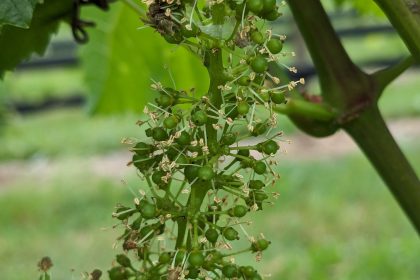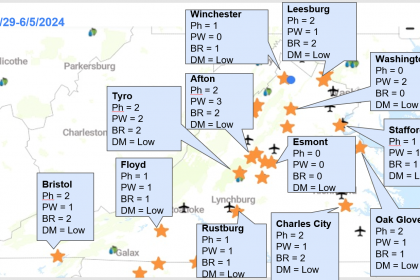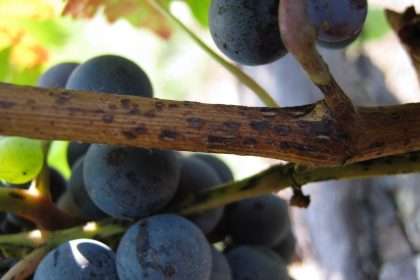The ongoing rain event since yesterday morning (5/3/09, 8 am) has been relatively cold. Starting temperature was about 52F, at mid-night it was 49F, and it has been lower 50’s today. It is low, but long enough (>33 hr so far) for Phomopsis to cause light (5-15% disease severity on a cane) to moderate (15-25%) disease. In addition, as of this morning, we have received 0.84 inches of rain since last week (and it’s still raining as of 4 pm, but looks like the end is coming!!). As for powdery mildew ascospore discharge, this rain event met the requirement.
A typical rule of thumb for fungicide re-application is “2 weeks or 1 inch of rain, whichever comes first” (Note: you need to adjust the time between applications based on the growth of vine). Please check your local weather for rain and temperature information. There is a banner of “weather underground” on the upper-right side where you can check your local weather information in detail by typing in your zip code (you can even go back in days to see what happened in the past few days).
For example, we applied mancozeb + sulfur on April 30th, but vines have grown an inch or more since then. It seems that when there is a break from this rain later this week, we need to apply fungicide for Phomopsis and powdery mildew to add protection to new growth. Please note that it typically requires at least 2 hours of dry period for a fungicide to properly adhere to the plant surface.
Since rain events in these several days are relatively cold and continous (black rot fungus’ spore requires a few hours of dry event to adhere to the grape tissue surface), I think the risk of black rot is low at Winchester. (Also, if you have mancozeb or Ziram for your next application, it will cover black rot too.) However, I encourage you to check your local weather, especially you had black rot issues in the past. As you may know, if you have mummified berries from last year hanging from your vines, it increases a risk of black rot thoughout the season, so, please take them out. [FYI: If you think the risk of black rot is very high in your vineyard, you may apply mycrobutanil (Rally) which has a good kick-back activity, but at the same time, you probably want to save it until later to protect your berries. It will be your judgement call.]
Rain probably makes you think about downy mildew too. It has been warm enough (>50F during the rain) for its over-winter structure (Oospore) to produce spores (zoospores). However, it requires warmer weather (65-75F) to grow and reproduce in a significant way. In addition, chemicals for Phomopsis (mancozeb, captan, Ziram) and black rot (mancozeb and Ziram [captan is not as good as Mancozeb against black rot]) also have an efficacy against downy mildew.
I sent a note through the “grape note” email list today which talks about early season grape disease management tips. If you wish to receive email from either our viticulturist Dr. Tony Wolf or me, please send me an email so that we can add your name to the list.





